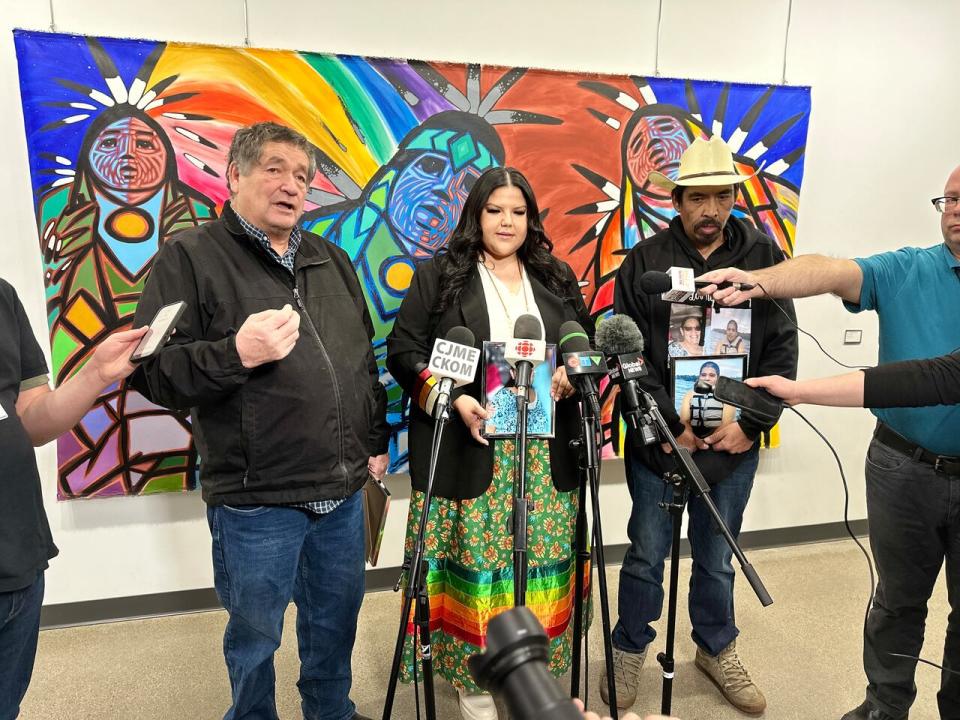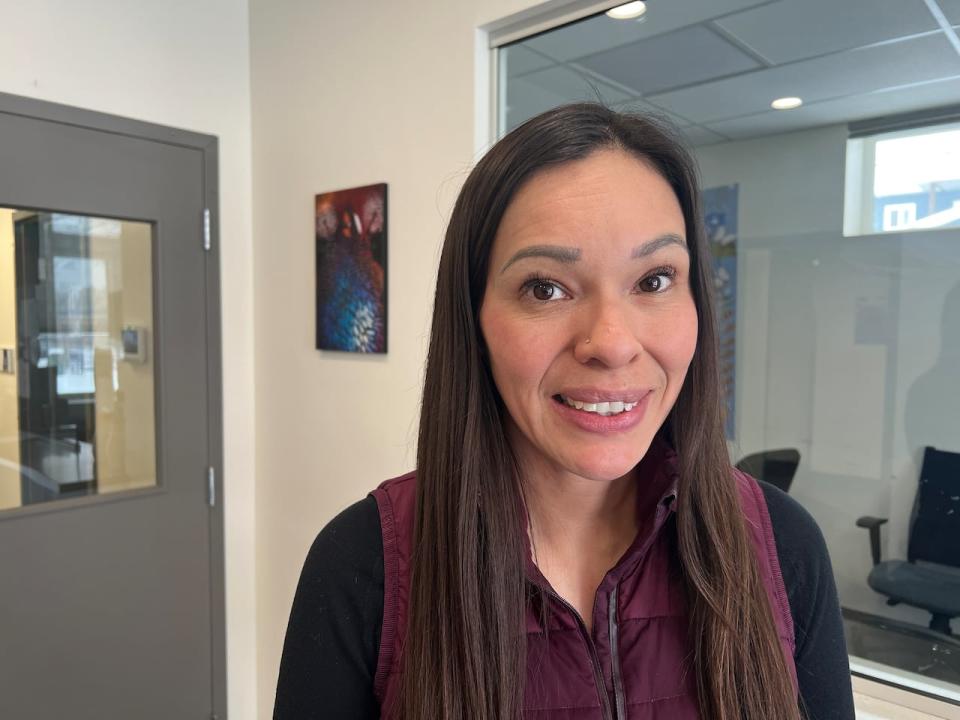James Smith inquest boosts Indigenous prison programs. Grassroots groups say their work is more effective

The cerulean and indigo fabric on the twin bed provides the only pop of colour in a mostly grey and white room. Tacked on top is a letter with the words "made especially for you."
Each woman who stays at īkwēskīcik iskwēwak, a transitional home in Saskatoon for women leaving jail, gets a quilt like this.
"It just gives them a sense that 'somebody cares for me,'" said Crystal LaPlante, who oversees justice programs for the Saskatoon Tribal Council. "For the ones that have been abused, the ones told they're nothing — this says, 'You are loved.'"
Grassroots resources for Indigenous offenders, like īkwēskīcik iskwēwak, are where real change happens, according to those with lived experience and their advocates.
While many recommendations from a recent inquest into Canada's worst mass stabbing focus on support for offenders while they're in prison, others say it's time to pour more resources into community-based programs.
"It's a different way of doing business, so to speak," said LaPlante. "But with our very high overrepresentation rates of Indigenous incarceration, we know the current system isn't working."
Inquest heard need for mental health, addictions resources
In September 2022, 32-year-old Myles Sanderson from James Smith Cree Nation in Saskatchewan stabbed 11 people to death and wounded 17 others. After an almost four-day manhunt, Sanderson died in police custody.
At a provincial coroner's inquest in January, a jury heard that Sanderson attacked members of his community despite the fact that he had completed several programs in prison to address his struggles with addictions, intergenerational trauma and domestic abuse.

Darryl Burns, left, Chelsey Stonestand, centre, and Brian (Buggy) Burns speak with reporters in January after the jury announced its recommendations at the inquest into the 2022 mass stabbings on James Smith Cree Nation and nearby Weldon, Sask. (Chanss Lagaden/CBC)
The jury and coroner eventually made 29 recommendations to prevent future tragedies, at least eight of which explicitly focus on improving programs and resources run by Correctional Service Canada (CSC). A CSC spokesperson said the organization is reviewing the inquest recommendations.
Most of those recommendations stemmed from testimony where witnesses described an overburdened system with long wait lists for psychiatric care and Indigenous-focused programs.
That's where places such as īkwēskīcik iskwēwak can fill the void, says LaPlante, since in-custody programs can be hard to navigate with time and access constraints.
"We have two registered psychiatric nurses on staff. We have mental health and addictions support. We have case workers. We have the elders," she said.
"We want this to be a one-stop shop so women can be successful."

Crystal LaPlante, justice director at Saskatoon Tribal Council, says having a space for women leaving jail that has holistic supports makes a big difference in addressing the Indigenous overrepresentation in custody. (Sam Samson/CBC)
Plans for this transitional home, whose name means "women turning their lives around" in Cree, started years before the 2022 mass murder. It has provincial and federal funding, but it's primarily run by the Saskatoon Tribal Council.
That holistic, Indigenous-led approach makes a difference for 29-year-old Shayla Shingoose.
"I want to learn more about my culture, because growing up, I didn't really know much about it," she said. "I've just started now, and I'm learning a lot from staying here in this place."

Shayla Shingoose, 29, says cultural supports help her address her addictions and avoid going back to jail. (Sam Samson/CBC)
Shingoose, who is from Waywayseecappo First Nation in Manitoba, came here last summer after a few months in jail. Since then, she's been to her first sweat lodge and made her first ribbon skirt — cultural practices she said helps her address her addictions.
"I probably would have gone back to my old ways because I didn't have much as much support [before] as I do today," she said.
"It feels very good just to be doing daily things like waking up in the morning and then we smudge."
In-custody resources only go so far: experts
Though Indigenous people make up about five per cent of Canada's population, they account for 32 per cent of all people in custody, according to the federal government.
Correctional investigator Ivan Zinger said it was a "national travesty" in his latest report, which calls for Indigenous communities to have more power.
Zinger said current in-custody programs meant for Indigenous offenders don't address the problem of overrepresentation because they "serve too few people" and that "state-run healing lodges are funded, resourced and occupied at significantly higher levels than their 'grossly under-resourced' community-run counterparts."
Vicki Chartrand, a sociology professor at Bishop's University in Sherbrooke, Que., says that's why the jury's recommendations to boost CSC programs won't help.
"To make a recommendation to inject more money, more resources into an institution that has been designed to simply contain and control people, I think, is misguided," she said.
Chartrand founded the Centre for Justice Exchange, a research group focused on community-based justice. She said several communities are running their own successful justice programs across Canada, but they're working in silos.
She has applied for federal funding to document existing work so these grassroots programs can connect and grow.
New CSC changes bring hope
Marlene Orr says she's seen CSC collaborate with community-based programs more since its new deputy commissioner for Indigenous corrections, Kathy Neil, started last year.
"They're moving to really address the ongoing criticism that has come not just from the correctional investigator but from community over the years," said Orr, the CEO of Native Counselling Services of Alberta (NCSA), which has operated for more than 50 years.
"I see that they're acting. It's not just talk," said Orr.

Marlene Orr, CEO of Native Counselling Services of Alberta, hopes the federal corrections system collaborates more often with grassroots programs like the ones she oversees. (Peter Evans/CBC)
One big change came just months ago, when Orr said NCSA's federally recognized healing lodges extended supervision of offenders on conditional release into their home communities to finish their sentences while CSC maintains case management decision-making.
The move reflects a recommendation from the recent Saskatchewan inquest to create a better continuum of care for Indigenous offenders.
"We know them well enough to know when they're starting to fall off the rails, when they're falling off their healing path, and we're able to provide interventions to get them on track," said Orr.
She says the more Canada invests in Indigenous-led programs outside of custody, the more it can address the effects of intergenerational trauma so many First Nations, Métis and Inuit offenders struggle with.
"We understand how it's important to replace an imposed identity of shame with an identity of cultural pride, and then to bring people gently into our culture, so that they can understand the teachings and the values that are embedded in the teachings," she said.


